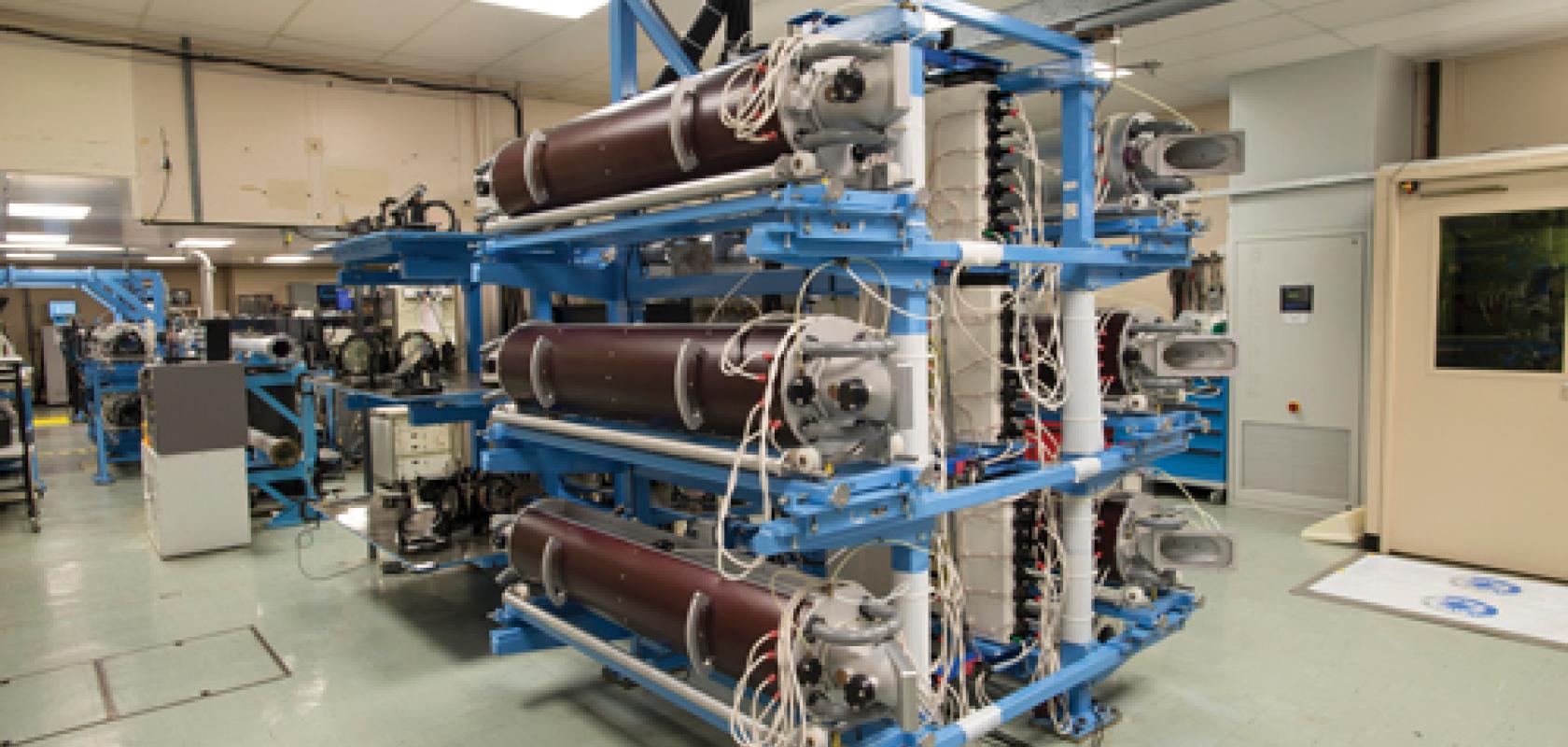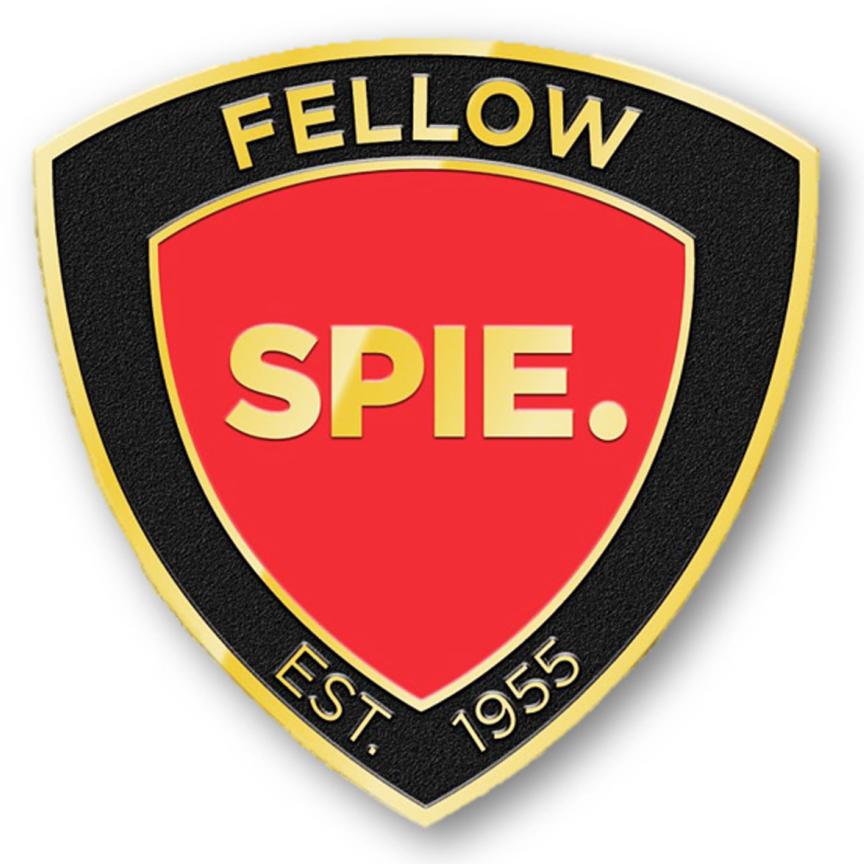The ultrafast lasers of the 1970s were behemoths, dominating lab space from floor to ceiling. Today’s commercial ultrafast lasers are much more compact, fitting on a standard optical table or within medical devices, but according to Olivia Wheeler-Williams, an ultrafast optical engineer for Edmund Optics, customers want them to be even smaller.
‘In the last five years, there’s been a huge push in the ultrafast laser market toward more compact and more rugged ultrafast laser assemblies,’ she said.
Chirped pulse amplification
The path to developing compact ultrafast lasers has not been straightforward. The first ultrafast lasers had a huge footprint, in part to prevent them from damage. The high energy beams used posed problems for many components, particularly amplifiers, as nonlinear processes would occur once the maximum intensity of the pulses reached the order of gigawatts per square centimetre.
Initially, researchers at Lawrence Livermore National Laboratory in California got around this issue by upscaling the amplifiers by tens of centimetres. However, by the mid-80s, these extra-large amplifiers were no longer needed. Using a Ti:sapphire laser, Gerard Mourou and Donna Strickland developed chirped pulse amplification – a technique originally used in radar systems and now a mainstay of high-power ultrafast lasers.
Mourou and Strickland’s development enabled the reduction of both the size and cost of ultrafast laser systems, and eventually earned them a Nobel Prize in Physics. Using diffraction gratings, the original laser pulse is temporally separated into its individual wavelength components. This reduces the intensity, making it possible to amplify the pulses in the laser cavity without damaging the optics in the system. The amplified pulses are then recompressed to their original length.
Chirped pulse amplification enabled much higher peak power to be reached. Now, the world’s most powerful ultrafast lasers, like the Vulcan laser at the Rutherford Appleton Laboratory in Oxfordshire, UK, the Gekko XII at the Institute for Laser Engineering at Osaka University, Japan, and the High Power Laser System in Măgurele, Romania, can generate pulses with peak powers measured in petawatts.
The green problem
For decades, the Ti:sapphire laser has been the ultrafast workhorse, owing to its tunability and generation of high energy ultrashort pulses. But these systems were costly, both in terms of money and space.
Ti:sapphire lasers – which are most efficient around 800nm – usually require a green pump source. The issue, according to Richard McCracken from Heriot-Watt University in Edinburgh’s Laser Innovation Lab, is the quality of lasers in those wavelengths. ‘A Ti:sapphire runs at 800nm and it’s pumped at 530nm, and the pump source for that is usually a 5-6W laser system. But there are no laser systems with that amount of power at that wavelength,’ he said.
Historically, the workarounds required additional expensive – and large – lasers. For example, to get enough power, researchers could take an 890nm laser and use that to pump another laser which would then be frequency-doubled to a green wavelength.
McCracken added: ‘In the past 10 years or so, the price of green and blue laser diodes has come down, and the quality and output power has gone up. So, now, people are pumping these Ti:sapphire lasers with very compact laser diodes. These diodes produce 2-3W on their own, and you can multiplex them together to increase the power.’
An expanding market
The development of ultrashort pulse laser systems was initially driven by researchers studying strong-field atomic physics. However, many recent advances have been driven by industrial, medical, and commercial markets. ‘The industrial market is moving toward easier-to-use, fibre-based ultrafast lasers that tend to be more stable and more compact,’ said Wheeler-Williams from Edmund Optics. ‘If you’re in an industrial market, then the time that you spend tweaking your laser system is money.’
One of the biggest challenges in developing ultrafast lasers is maintaining the pulse duration. Any optical medium, such as an objective lens, will stretch the pulse in time. Commercial systems need to be low maintenance and reliable for applications ranging from laser cutting and welding, to ophthalmology and aesthetics.
Over the past two years, Edmund Optics has begun to seriously expand its offerings in ultrafast lasers. The firm holds an inventory of ultrafast optics including compression gratings, compression prisms and highly dispersive mirrors, and are able to work with customers to develop custom components for specific applications.
At the end of 2020, Edmund Optics acquired Quality Thin Films, a company that produces crystals for solid-state ultrafast lasers. For high-power systems, the materials used to coat crystals and optics are critical in preventing damage caused by nonlinear effects. Wheeler-Williams said: ‘Acquiring this Florida facility has now allowed us to not only gain the physical space, but also their expertise in laser crystal coating and processing.’
In 2021, Edmund Optics partnered with UltraFast Innovations, a German manufacturer of premium laser optics. UltraFast Innovations produce mirrors for ultrafast pulse compression and pulse duration maintenance.
Wheeler-Williams said: ‘To partner with a company like UltraFast Innovations – which has this long history and incredible expertise in making the best dispersive mirrors available on the market – has been a really exciting push for us. Laser optics, in general, for us is expanding rapidly and we’re excited to see where it goes.’
Fast frequency combs
As ultrafast lasers become more compact and stable, new markets are emerging. Researchers at Heriot-Watt University are developing some of the most compact solid-state lasers yet for use as frequency combs.
Frequency combs act as a kind of optical ruler. McCracken from Heriot-Watt explained: ‘A mode-locked laser produces an infinite series of pulses in the time domain. But in the frequency domain, the output spectrum of that laser looks like a set of delta functions underneath some broad spectral envelope. So, if you zoom into the spectral output of a mode-locked laser that’s got some Gaussian-type spectrum, you will see a series of hyperfine frequency lines. And each of those frequency lines is separated by the repetition rate of the laser.’
These frequency combs can be used as timekeeping devices and have applications in a broad range of sectors including security, energy, geodesy, finance and defence. Derryck Reid, principal investigator of Heriot-Watt’s ultrafast optics group, added: ‘Clearly these systems need not only to be small, self-contained modules, but also must be self-starting and robust to environmental perturbations.’
The Heriot-Watt researchers have also developed compact ultrafast laser systems called astrocombs, specifically for space applications. ‘Astronomers use these as a local reference to calibrate the precision of their spectrograph,’ McCracken said. ‘When you’re looking for Earth-like exoplanets orbiting around distant stars, you’re looking for really small Doppler shifts in the received starlight from that system.’
Astronomers are observing these small shifts over long periods of time – often for over a year – and need to be certain that the spectrograph they’re measuring with is calibrated to a high degree of precision. Researchers take an astrocomb, expand its spectrum through nonlinear effects – for example, in a supercontinuum fibre – so that it covers a broad spectrum range, and direct that light onto the spectrograph where they will see the individual comb modes from the laser system.
When developing such compact systems, engineering is the primary challenge. ‘It’s a reciprocal relationship between the repetition frequency of the laser and the length of your laser cavity,’ McCracken explained. ‘So, if we’re looking to build something that’s maybe a 10GHz system, that’s a 3cm cavity length. We had to come up with interesting ways to hold the optics, and to manufacture really tight radius of curvature optics.’
Working closely with Airbus Germany, the researchers have developed proprietary cavity-element bonding and alignment processes. The result removes the need for the characteristic adjustable mounts used inside laser boxes and on optical benches. Reid said: ‘This make the laser more reliable by removing any components which are easily misaligned, and also reduces its footprint significantly.’
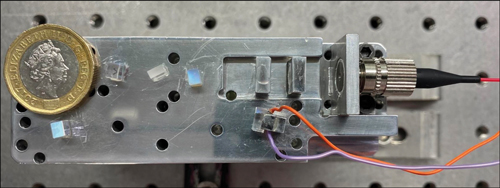
A 2.2GHz Yb:ceramic ring laser producing 150fs pulses. Credit: Derryck Reid and Hanna Ostapenko, Heriot-Watt University
Hanna Ostapenko, a PhD student, has developed one of the group’s smallest ultrafast lasers yet: a Yb:ceramic ring laser producing 150fs pulses. Ostapenko’s system required meticulous preparation and modelling. ‘As the laser is very small, micrometre changes in mirror positions can destabilise the mode-locking,’ she said.
Unlike Ti:sapphire lasers – which usually require the manual movement of a mirror to begin mode-locking – Yb:ceramics are self-starting Kerr-lens systems; once the laser is turned on it begins mode-locking and producing pulses.
Ostapenko’s system is a big step towards space-qualifying compact ultrafast lasers, as the laser can maintain its frequency properties while in motion. ‘It should withstand the extreme accelerations associated with a satellite launch,’ said Ostapenko. ‘It can be easily carried or installed in places where vibrations are a part of the environment, like planes or satellites, without the need to realign it.’
To ensure long-term stability, the laser has a temperature control system. By changing the temperature, Ostapenko can vary the repetition rate by 100kHz.
When designing ultrafast systems this small, researchers face considerable hurdles – as the laser cavity gets smaller, the peak power of the circulating pulses decreases. Reid explained: ‘This means that the nonlinear effects on which ultrafast lasers depend become weaker, because their strength scales with peak power. Consequently, obtaining high quality mode-locking at high repetition frequencies becomes more challenging.’
Sponsored: Hard gold coated mirrors for high power fibre laser applications
Industrial ytterbium ~1 micron wavelength near-infrared fibre lasers first emerged in the late 1990s. At this time, they were less than 10W of optical power and standard coated BK7 could be used for both reflective and transmissive beam delivery optics. During the 1990s fibre laser development moved at a very rapid rate, with 100W and then 200W lasers becoming industrially available in the early 2000s. At these power density levels, in some applications, BK7 became infeasible because of thermal effects. There are two main effects:
• Thermal lensing due to refractive index shift as well as uneven thermal expansion.
• Thermally induced coating wavelength shift giving reflectivity and absorption shifts.
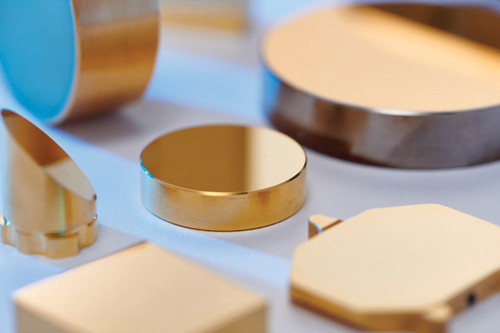
Credit: LBP Optics
High-quality oxygen-free fused silica with suitable dielectric coatings became the best choice for transmissive and reflective optics for these applications. Subsequently, fibre laser development has continued at an accelerating pace with up to 10kW TEM00 lasers now being offered. Similarly, the parallel technology of thin disk lasers is offering lasers with comparable power levels. These power levels present massive challenges to the design of beam processing and delivery systems, bringing into question the survival and performance of coated fused silica optics.
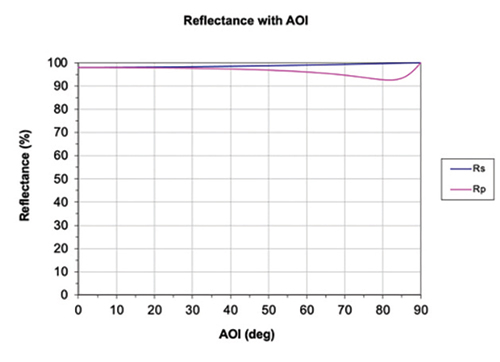
Figure 1
A novel solution for reflective optics for high-power near-infrared lasers is the use of our hard gold-coated copper mirrors. Hard gold-coated nickel copper (NiCu) mirrors are the most widely used of all the Cu mirror types. They consist of a copper substrate, precision-lapped to the required surface form, plated with a thin layer of nickel that is polished and hard gold-coated. They have been industry-standard in 10.6 micron CO2 laser applications for decades. They are also currently being used in multiple industrial applications with high-power fibre lasers with great success. The features of hard gold-coated copper mirrors include the following:
• Robustness of the hard gold coating has been demonstrated industrially at high laser power intensities for both CW and pulsed applications.
• The gold coating on copper is more resistant to runaway coating failure, due to minor contamination or scratches, compared to dielectric coating on fused silica. This is due to the high thermal conductivity of both the gold coating and the copper substrate reducing localised temperature change.
• The gold coating has slightly lower reflectivity compared to dielectric coatings, but this is mitigated by the dramatically higher thermal conductivity of the copper compared to fused silica.
• A ratio of approximately 270:1! Consequently, thermal lensing due to inhomogeneous thermal expansion is eliminated.
• The gold coating is largely insensitive to the angle of incidence (AOI) and beam polarisation; typically Rs and Rp of 97.9 per cent at 0 AOI and Rs of 98.5 per cent and Rp 97.1 per cent at 45 AOI at 1.07 microns wavelength. This feature extends to much greater AOI, as shown in figure 1.
• Gold coatings are not limited to 1.07 micron wavelength, being useable at all wavelengths from 0.8 microns up to 10.6 microns and beyond. The feature of adequate reflectivity in the visible allows the use of coaxial visible pointing beams common with fibre lasers (see figure 2).
• Unlike vacuum deposited hard gold coatings, electroplated gold never peels, flakes or delaminates.
• Water cooling channels can be incorporated into the copper mirror with custom mirror shapes being possible, also with integral mounting holes and faces. These features offer direct cooling of the mirror as well as simplified mounting, and eliminate thermal mount shifting effects.
• The mirror surface can be planar or can be Single Point Diamond Turned (SPDT) to a spherical, parabolic, toric or one of many other geometries. The mirror can have many functions other than just beam bending.
• The gold surface can be removed and replaced to refurbish a worn, scratched mirror surface. This can be attractive for complex mirror geometries.
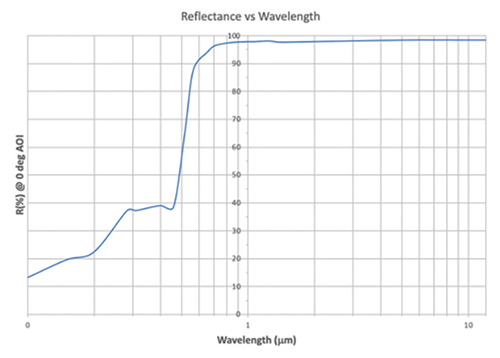
Figure 2
Consequently, hard gold-coated NiCu reflective optics avoid the problems of thermal effects on the bulk material or coatings common with coated fused silica optics, as well as offering a host of other benefits and possibilities.
These mirrors are available from stock or to order for custom solutions from LBP Optics Ltd, tel: +441767600877, email: sales@lbpoptics.com

